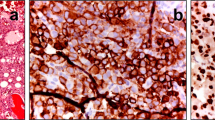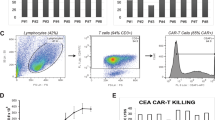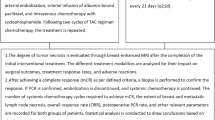Abstract
Isolated limb perfusion (ILP) with melphalan is effective in the treatment of small multiple melanoma intransit metastases and is utilized widely for this indication. The treatment is much less effective against bulky melanoma metastases and has uniformly failed in the treatment of irresectable extremity soft tissue sarcomas. The addition of tumor-necrosis factor-α (TNF-α) to this treatment approach has changed the situation dramatically. High response rates and limb-salvage rates have been reported in multicenter trials that combined ILP with TNF-α plus melphalan; these trials resulted in the approval of TNF-α for bulky melanoma metastases and soft tissue sarcomas in Europe in 1998. Subsequently, many doctors working in European centers have been trained, and a series of confirmatory reports from single institutions have now been published regarding the efficacy of the procedure. TNF-α has an early and a late effect; it enhances tumor-selective drug uptake during the perfusion, and plays an essential role in the subsequent selective destruction of the tumor vasculature. These effects result in a high response rate in bulky tumors, soft tissue sarcomas, bulky melanomas, and various other tumor types. This induction therapy therefore allows tumor remnants to be resected some 3 months after ILP thus avoiding limb amputation. TNF-α-based ILP is a well-established treatment that aims to avoid amputations regardless of the tumor size and type. It represents an important example of combination therapy that modulates the tumor vasculature and should be offered in high-volume tertiary referral centers.
Key Points
-
The use of tumor-necrosis factor-α (TNF-α) in the isolated limb perfusion (ILP) setting for soft tissue sarcoma (STS) treatment showed impressive response rates, and subsequent confirmation in multicenter trials led to the approval and registration of this regimen in Europe
-
Data from studies assessing dosage in STS showed that TNF-α doses of 1 mg (for the arm) and 1–2 mg (for the leg) are sufficient
-
High limb-salvage and response rates were seen in patients with metastatic disease who received TNF-α-based ILP palliative therapy
-
In patients with melanoma intransit metastases, amputation is seldom beneficial and TNF-α-based ILP therapy is an attractive option, with very high reported response rates (95%) and limb salvage rates (99%)
-
TNF-α-based ILP is an excellent tool for achieving local control and avoiding limb amputations in patients with limb-threatening tumors
This is a preview of subscription content, access via your institution
Access options
Subscribe to this journal
Receive 12 print issues and online access
$209.00 per year
only $17.42 per issue
Buy this article
- Purchase on Springer Link
- Instant access to full article PDF
Prices may be subject to local taxes which are calculated during checkout


Similar content being viewed by others

References
Creech O Jr et al. (1958) Chemotherapy of cancer: regional perfusion utilizing an extracorporeal circuit. Ann Surg 148: 616–632
Benckhuijsen C et al. (1988) Regional perfusion treatment with melphalan for melanoma in a limb: an evaluation of drug kinetics. Eur J Surg Oncol 14: 157–63
Thompson JF and Gianoutsos MP (1992) Isolated limb perfusion for melanoma: effectiveness and toxicity of cisplatin compared with that of melphalan and other drugs. World J Surg 16: 227–233
Wieberdink K et al. (1982) Dosimetry in isolation perfusion of the limbs by assessment of perfused tissue volume and grading of toxic tissue reactions. Eur J Cancer Clin Oncol 18: 905–910
Stotter AT et al. (1990) The influence of local recurrence of extremity soft tissue sarcoma on metastasis and survival. Cancer 65: 1119–1129
Gustafson P et al. (1991) Is local recurrence of minor importance for metastases in soft tissue sarcoma? Cancer 67: 2083–2086
Rosenberg SA et al. (1982) The treatment of soft-tissue sarcomas of the extremities: prospective randomized evaluations of (1) limb-sparing surgery plus radiation therapy compared with amputation and (2) the role of adjuvant chemotherapy. Ann Surg 196: 305–315
Williard WC et al. (1992) Comparison of amputation with limb-sparing operations for adult soft tissue sarcoma of the extremity. Ann Surg 215: 269–275
Meric F et al. (2002) Radiographic response to neoadjuvant chemotherapy is a predictor of local control and survival in soft tissue sarcomas. Cancer 95: 1120–1126
O'Sullivan B et al. (2002) Preoperative versus postoperative radiotherapy in soft-tissue sarcoma of the limbs: a randomised trial. Lancet 359: 2235–2241
Pisters PW et al. (2002) Preoperative chemoradiation treatment strategies for localized sarcoma. Ann Surg Oncol 9: 535–542
DeLaney TF et al. (2003) Neoadjuvant chemotherapy and radiotherapy for large extremity soft-tissue sarcomas. Int J Radiat Oncol Biol Phys 56: 1117–1127
Krementz ET et al. (1977) Chemotherapy of sarcomas of the limbs by regional perfusion. Ann Surg 185: 555–564
Pommier RF et al. (1988) Pharmacokinetics, toxicity, and short-term results of cisplatin hyperthermic isolated limb perfusion for soft tissue sarcoma and melanoma of the extremities. Am J Surg 155: 667–671
Klaase JM et al. (1989) Results of regional isolation perfusion with cytostatics in patients with soft tissue tumors of the extremities. Cancer 64: 616–621
Rossi CR et al. (1994) Phase II study on neoadjuvant hyperthermic-antiblastic perfusion with doxorubicin in patients with intermediate or high grade limb sarcomas. Cancer 73: 2140–2146
Feig BW et al. (2004) A prospective evaluation of isolated limb perfusion with doxorubicin in patients with unresectable extremity sarcomas. Ann Surg Oncol 11: S80
Lienard D et al. (1992) High-dose recombinant tumor necrosis factor alpha in combination with interferon gamma and melphalan in isolation perfusion of the limbs for melanoma and sarcoma. J Clin Oncol 10: 50–62
Eggermont AM et al. (1996) Isolated limb perfusion with high-dose tumor necrosis factor-α in combination with interferon-γ and melphalan for nonresectable extremity soft tissue sarcomas: a multicenter trial. J Clin Oncol 14: 2653–2665
Eggermont AM and Kirkwood JM (2004) Re-evaluating the role of dacarbazine in metastatic melanoma: what have we learned in 30 years? Eur J Cancer 40: 1825–1836
Lejeune FJ et al. (1993) Regional therapy of melanoma. Eur J Cancer 29A: 606–612
Fraker DL et al. (1996) Treatment of patients with melanoma of the extremity using hyperthermic isolated limb perfusion with melphalan, tumor necrosis factor, and interferon gamma: results of a tumor necrosis factor dose-escalation study. J Clin Oncol 14: 479–89
Eggermont AM et al. (1993) Treatment of irresectable soft tissue sarcomas of the limbs by isolation perfusion with high dose TNF-α in combination with γ-interferon and melphalan. In Tumor Necrosis Factor: Molecular and Cellular Biology and Clinical Relevance, 239–243 (Eds Fiers W and Buurman WA) Basel: Karger
Eggermont AM et al. (1996) Isolated limb perfusion with tumor necrosis factor and melphalan for limb salvage in 186 patients with locally advanced soft tissue extremity sarcomas: the cumulative multicenter European experience. Ann Surg 224: 756–764
Eggermont AM et al. (1999) Limb salvage by isolation limb perfusion with tumor necrosis factor alpha and melphalan for locally advanced extremity soft tissue sarcomas: results of 270 perfusions in 246 patients. Proc Am Soc Clin Oncol 11: 497
Santinami M et al. (1996) Treatment of recurrent sarcoma of the extremities by isolated perfusion using tumor necrosis factor alpha and melphalan. Tumori 82: 579–584
Gutman M et al. (1997) High dose tumor necrosis factor-α and melphalan administered via isolated limb perfusion for advanced limb soft tissue sarcoma results in a >90% response rate and limb preservation. Cancer 79: 1129–1137
Olieman AF et al. (1998) Feasibility and efficacy of external beam radiotherapy after hyperthermic isolated limb perfusion with TNF-α and melphalan for limb-saving treatment in locally advanced extremity soft-tissue sarcoma. Int J Radiat Oncol Biol Phys 40: 807–814
Olieman AF et al. (1998) Hyperthermic isolated limb perfusion with tumour necrosis factor-α and melphalan as palliative limb-saving treatment in patients with locally advanced soft-tissue sarcomas of the extremities with regional or distant metastases: is it worthwhile? Arch Orthop Trauma Surg 118: 70–74
Rossi CR et al. (1999) Soft tissue limb sarcomas: Italian clinical trials with hyperthermic antiblastic perfusion. Cancer 86: 1742–1749
Lev-Chelouche D et al. (1999) Multifocal soft tissue sarcoma: limb salvage following hyperthermic isolated limb perfusion with high-dose tumor necrosis factor and melphalan. J Surg Oncol 70: 185–189
Lev-Chelouche D et al. (1999) Limb desmoid tumors: a possible role for isolated limb perfusion with tumor necrosis factor-α and melphalan. Surgery 126: 963–967
Lev-Chelouche D et al. (1999) Isolated limb perfusion with high-dose tumor necrosis factor alpha and melphalan for Kaposi sarcoma. Arch Surg 134: 177–180
Lejeune FJ et al. (2000) Limb salvage by neoadjuvant isolated perfusion with TNFα and melphalan for non-resectable soft tissue sarcoma of the extremities. Eur J Surg Oncol 26: 669–678
Hohenberger P et al. (2001) Functional outcome after preoperative isolated limb perfusion with rhTNFα/melphalan for high-grade extremity sarcoma. Eur J Cancer 37: S34–S35
Lans TE et al. (2002) Isolated limb perfusion with tumor necrosis factor and melphalan for nonresectable Stewart-Treves lymphangiosarcoma. Ann Surg Oncol 9: 1004–1009
Noorda EM et al. (2003) Isolated limb perfusion with tumor necrosis factor-α and melphalan for irresectable soft tissue sarcoma of the extremities. Cancer 98: 1483–1490
van Etten B et al. (2003) Fifty tumor necrosis factor-based isolated limb perfusions for limb salvage in patients older than 75 years with limb-threatening soft tissue sarcomas and other extremity tumors. Ann Surg Oncol 27: 32–37
Grünhagen DJ et al. (2005) Isolated limb perfusion with tumor necrosis factor and melphalan prevents amputation in patients with multiple sarcomas in arm or leg. Ann Surg Oncol 12: 473–479
Lans TE et al. (2005) Isolated limb perfusions with tumor necrosis factor and melphalan for locally recurrent soft tissue sarcoma in previously irradiated limbs. Ann Surg Oncol 12: 406–411
Grünhagen DJ et al. (2006) The palliative value of tumor necrosis factor alpha-based isolated limb perfusion in patients with metastatic sarcoma and melanoma. Cancer 106: 156–162
Grünhagen DJ et al. (2005) TNF-based isolated limb perfusion for unresectable extremity desmoid tumors. Eur J Surg Oncol 31: 912–916
Rossi CR et al. (2005) Hyperthermic isolated perfusion with low-dose tumor necrosis factor alpha and doxorubicin for the treatment of limb-threatening soft tissue sarcomas. Ann Surg Oncol 12: 398–405
Grünhagen DJ et al.: Outcome and prognostic factor analysis of 217 consecutive isolated limb perfusions with tumor necrosis factor-α and melphalan for limb-threatening soft tissue sarcoma. Cancer, in press
Bonvalot S et al. (2005) Limb salvage with isolated perfusion for soft tissue sarcoma: could less TNF-α be better? Ann Oncol 16: 1061–1068
Grünhagen DJ et al. (2005) TNF dose reduction in isolated limb perfusion. Eur J Surg Oncol 31: 1011–1019
Hill S et al. (1993) Low dose tumor necrosis factor-α and melphalan in hyperthermic isolated limb perfusion. Br J Surg 80: 995–997
de Wilt JH et al. (1999) Prerequisites for effective isolated limb perfusion using tumour necrosis factor alpha and melphalan in rats. Br J Cancer 80: 161–166
Vrouenraets BC et al. (1999) Absence of severe systemic toxicity after leakage controlled isolated limb perfusion with tumor necrosis factor-α and melphalan. Ann Surg Oncol 6: 405–412
Stam TC et al. (2000) Systemic toxicity and cytokine/acute phase protein levels in patients after isolated limb perfusion with tumor necrosis factor-α complicated by high leakage Ann Surg Oncol 7: 268–275
Vrouenraets BC et al. (2001) Regional toxicity after isolated limb perfusion with melphalan and tumour necrosis factor-α versus toxicity after melphalan alone. Eur J Surg Oncol 27: 390–395
Eggermont AM (1996) Treatment of melanoma in-transit metastases confined to the limb. Cancer Surv 26: 335–349
Lejeune FJ et al. (1994) Rationale for using TNF alpha and chemotherapy in regional therapy of melanoma. J Cell Biochem 56: 52–61
Lienard D et al. (1999) Isolated limb perfusion with tumour necrosis factor-α and melphalan with or without interferon-γ for the treatment of in-transit melanoma metastases: a multicentre randomized phase II study. Melanoma Res 9: 491–502
Grünhagen DJ et al. (2004) One hundred consecutive isolated limb perfusions with TNF-α and melphalan in melanoma patients with multiple in-transit metastases. Ann Surg 240: 939–947
Fraker DL et al. (2002) A phase III trial of isolated limb perfusion for extremity melanoma comparing melphalan alone versus melphalan plus tumor necrosis factor (TNF) plus interferon gamma (IFN). Ann Surg Oncol 9 (Suppl): S8
Rossi CR et al. (2004) Hyperthermic isolated limb perfusion with low-dose tumor necrosis factor-α and melphalan for bulky in-transit melanoma metastases. Ann Surg Oncol 11: 173–177
Grünhagen DJ et al. (2005) Efficacy of repeat isolated limb perfusions with tumor necrosis factor alpha and melphalan for multiple in-transit metastases in patients with prior isolated limb perfusion failure. Ann Surg Oncol 12: 609–615
Olieman AF et al. (1999) Hyperthermic isolated limb perfusion with tumor necrosis factor alpha, interferon gamma, and melphalan for locally advanced nonmelanoma skin tumors of the extremities: a multicenter study. Arch Surg 134: 303–307
Bickels J et al. (1999) Isolated limb perfusion with tumour necrosis factor-alpha and melphalan for unresectable bone sarcomas of the lower extremity. Eur J Surg Oncol 25: 509–514
Sijens PE et al. (1995) 31P magnetic resonance spectroscopy as predictor for clinical response in human extremity sarcomas treated by single dose TNF-α + melphalan isolated limb perfusion. NMR Biomed 18: 215–224
Rüegg C et al. (1998) Evidence for the involvement of endothelial cell integrin αVβ3 in the disruption of the tumor vasculature induced by TNF and IFN-γ. Nat Med 4: 408–414
Renard N et al. (1994) Early endothelium activation and polymorphonuclear cell invasion precede specific necrosis of human melanoma and sarcoma treated by intravascular high-dose tumour necrosis factor alpha (TNFα). Int J Cancer 57: 656–663
Nooijen PTGA et al. (1998) Complete response of melanoma in-transit metastasis after isolated limb perfusion with tumor necrosis factor-α and melphalan without massive tumor necrosis: clinical and histopathological study of the delayed-type reaction patterns. Cancer Res 58: 4880–4887
Kristensen CA et al. (1996) Reduction of interstitial fluid pressure after TNF-α treatment of three human melanoma xenografts. Br J Cancer 74: 533–536
de Wilt JH et al. (2000) Tumour necrosis factor alpha increases melphalan concentration in tumour tissue after isolated limb perfusion. Br J Cancer 82: 1000–1003
van der Veen AH et al. (2000) TNF-alpha augments intratumoural concentration of doxorubicin in TNF-α-based isolated limb perfusion in rat sarcoma models and enhances antitumour effects. Br J Cancer 82: 973–980
van Etten B et al. (2003) Degree of tumour vascularity correlates with drug accumulation and tumour response upon TNF-based isolated hepatic perfusion. Br J Cancer 87: 314–319
Seynhaeve ALB et al. (2002) Isolated limb perfusion with actinomycin D and TNF-α results in improved tumour response in soft-tissue sarcoma-bearing rats but is accompanied by severe local toxicity. Br J Cancer 86: 1174–1179
Brunstein F et al. (2004) Synergistic antitumor activity of histamine plus melphalan in isolated limb perfusion: preclinical studies. J Natl Cancer Inst 96: 1603–1610
Hoving S et al. (2005) Synergistic antitumor response of interleukin 2 with melphalan in isolated limb perfusion in soft tissue sarcoma-bearing rats. Cancer Res 65: 4300–4308
ten Hagen TL et al. (2000) Low-dose tumor necrosis factor-α augments antitumor activity of stealth liposomal doxorubicin (DOXIL®) in soft tissue sarcoma-bearing rats. Int J Cancer 87: 829–837
Brouckaert P et al. (2004) Tumor necrosis factor-α augmented tumor response in B16BL6 melanoma-bearing mice treated with stealth liposomal doxorubicin (Doxil®) correlates with altered Doxil® pharmacokinetics. Int J Cancer 109: 442–448
ten Hagen TL and Eggermont AM (2001) TNF is here to stay—revisited. Trends Immunol 22: 127–129
Author information
Authors and Affiliations
Corresponding author
Ethics declarations
Competing interests
The authors declare no competing financial interests.
Rights and permissions
About this article
Cite this article
Grünhagen, D., de Wilt, J., ten Hagen, T. et al. Technology Insight: utility of TNF-α-based isolated limb perfusion to avoid amputation of irresectable tumors of the extremities. Nat Rev Clin Oncol 3, 94–103 (2006). https://doi.org/10.1038/ncponc0426
Received:
Accepted:
Issue Date:
DOI: https://doi.org/10.1038/ncponc0426
This article is cited by
-
Autophagy-based unconventional secretion of HMGB1 in glioblastoma promotes chemosensitivity to temozolomide through macrophage M1-like polarization
Journal of Experimental & Clinical Cancer Research (2022)
-
Therapie von Hochrisiko-Weichteilsarkomen bei Erwachsenen
InFo Onkologie (2018)
-
Looking for answers: the current status of neoadjuvant treatment in localized soft tissue sarcomas
Cancer Chemotherapy and Pharmacology (2016)
-
The pathologic response of resected synovial sarcomas to hyperthermic isolated limb perfusion with melphalan and TNF-α: a comparison with the whole group of resected soft tissue sarcomas
World Journal of Surgical Oncology (2013)
-
Changes in Hepatic Blood Flow During Transcatheter Arterial Infusion with Heated Saline in Hepatic VX2 Tumor
CardioVascular and Interventional Radiology (2013)


